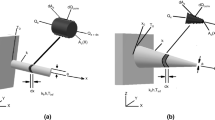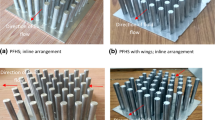Abstract
A Stepped circular pin-fin array is formulated numerically and optimized with Kriging metamodeling technique to enhance heat transfer performance. The problem is defined by two non-dimensional geometric design variables composed of height of the channel, height of smaller diameter part of the pin-fins, and smaller diameter of the pin-fins, to maximize heat transfer rate compromising with friction loss. Ten designs generated by Latin hypercube sampling were evaluated by three-dimensional Reynolds-averaged Navier–Stokes solver and the evaluated objectives were used to construct the surrogate model. The predictions of objective function by Kriging model at optimum point show reasonable accuracy in comparison with the values calculated by RANS analysis. Optimum shape of pin-fins strongly depends on the weighting factor which measures importance of the friction loss term in the objective function. The thermal performances are much higher than that of the straight pin-fin at sampling optimum points with different weighting factors.















Similar content being viewed by others
Abbreviations
- A :
-
Areas of heat transfer surface
- A d, A in :
-
Areas of heat transfer surface and inlet plane, respectively
- c p :
-
Specific heat
- D :
-
Larger diameter of the pin-fins
- D h :
-
Channel hydraulic diameter
- d :
-
Smaller diameter of the pin-fins
- F :
-
Objective function
- f :
-
Friction factor
- f 0 :
-
Reference friction factor
- H :
-
Height of the channel
- h :
-
Height of smaller diameter part of the pin-fins
- k :
-
Turbulence kinetic energy
- N :
-
Number of design variables
- Nu :
-
Local Nusselt number
- Nu 0 :
-
Reference Nusselt number
- Nu a :
-
Average Nusselt number
- \( \overline{Nu} \) :
-
Endwall area-averaged Nusselt number
- p, Δp:
-
Pressure and pressure drop in a channel, respectively
- \( \hat{p} \) :
-
Periodic component of pressure
- Pi :
-
Pitch
- Pr :
-
Prandtl number
- Pr t :
-
Turbulent Prandtl number
- q 0 :
-
Wall heat flux
- Re :
-
Reynolds number (= u b D h /ν)
- S :
-
Strain rate
- T :
-
Local mean temperature
- T w :
-
Wall temperature
- \( \hat{T} \) :
-
Periodic component of temperature
- u b :
-
Average axial velocity
- u i :
-
Mean velocity components (i = 1, 2, 3)
- W :
-
Cross-streamwise distance between two neighbored pin-fins
- x i :
-
Rectangular coordinates (i = 1, 2, 3) or design variables (Eq. 12)
- β :
-
Weighting factor in objective function in Eq. 10 or model constant in Eq. 6
- δ ij :
-
Kronecker delta (i = 1, 2, 3)
- γ :
-
Pressure gradient in streamwise direction
- μ, μ t :
-
Viscosity and turbulent viscosity, respectively
- ν, ν t :
-
Kinematic viscosity and eddy viscosity, respectively
- ρ :
-
Fluid density
- σ :
-
Increasing rate of bulk temperature in axial direction (Eq. 4) or standard deviation of the population (Eq. 12)
- σk, σω :
- ω :
-
Specific turbulence dissipation rate
References
Azar K, Mandrone CD (1994) Effect of pin fin density of the thermal performance of unshrouded pin fin heat sinks. Trans ASME 116:306–309
Chyu MK, Hsing YC, Shih TI-P, Natarajan V (1999) Heat transfer contributions of pins and endwall in pin-fin arrays: effects of thermal boundary condition modeling. J Turbomach 121:257–263
Hwang JJ, Lui CC (2002) Measurement of endwall heat transfer and pressure drop in a pin-fin wedge duct. Int J Heat Mass Transf 45:877–889
Ames FE, Dvorak LA, Morrow MJ (2004) Turbulent augmentation of internal convection over pins in staggered pin fin arrays. ASME Turbo Expo
Jeng TM, Tzeng SC (2007) Pressure drop and heat transfer or square pin-fin arrays in in-line and staggered arrangements. Int J Heat Mass Transf 51:2364–2375
Chyu MK (1990) Heat transfer and pressure drop for short pin-fin arrays with pin-endwall fillet. Trans ASME 112:926–932
Armstrong J, Winstanley D (1988) A review of staggered array pin fin heat transfer for turbine cooling applications. J Turbomach 110:94–103
VanFossen GJ (1980) Heat-transfer coefficients for staggered arrays of short pin-fins. ASME J Heat Transf 102:44–50
VanFossen GJ (1982) Heat transfer coefficient for staggered arrays of short pin fins. ASME J Eng Power 104:268–274
Brigham BA, VanFossen GJ (1984) Length-to-diameter ratio and row number effects in short pin fin heat transfer. ASME J Eng Gas Turbines Power 106:241–246
Metzger DE, Berry RA, Bronson JP (1982) Developing heat transfer in rectangular ducts with arrays of short pin fins. ASME J Heat Transf 104:700–706
Metzger DE, Haley SW (1982) Heat transfer experiments and flow visualization of arrays of short pin fins. ASME Paper No. 82-GT-138
Metzger DE, Fan ZX, Sheppard WB (1982) Pressure loss and heat transfer through multiple rows of short pin fins. Heat Transf 3:137–142
Metzger DE, Sheppard WB (1986) Row resolved heat transfer variations in pin fin arrays including effects of non-uniform arrays and flow convergence. ASME Paper No. 86-GT-132
Goldstein RJ, Jabbari MY, Chen SB (1994) Convective mass transfer and pressure loss characteristics of staggered short pin-fin arrays. Int J Heat Mass Transf 37(Suppl 1):149–160
Donahoo EE, Camci C, Kulkami AK, Belegundu AD (1999) A computational visualization of three-dimensional flow. ASME Turbo Expo, Indianapolis, IN, 99-GT-257
Andreini A, Carcasci C, Magi A (2004) Heat transfer analysis of a wedge shaped duct with pin fin and pedestal arrays. ASME Turbo Expo, Vienna, Austria, GT2004-53319
Saha AK, Acharya S (2004) Unsteady simulation of turbulent flow and heat transfer in a channel with periodic array of cubic pin-fins. Numer Heat Transf A 46:731–763
Chen HT, Chen PL, Horng JT, Hung YH (2005) Design optimization for pin-fin heat sinks. J Electron Packag 127:397–406
Park KW, Oh PK, Lim HJ (2005) Optimum design of a pin-fins type heat sink using the CFE and mathematical optimization. Int J Air Cond Refrig 13(2):71–82
Li Ping, Kim KY (2008) Multiobjective optimization of staggered elliptical pin-fin arrays. Numer Heat Transf A 53(4):418–431
Husain A, Kim KY (2008) Shape optimization of a micro-channel heat sink for micro-electronic cooling. IEEE Trans Compon Packag Technol 31(2):322–330
Raza W, Kim KY (2007) Evaluation of surrogate models in optimization of wire-wrapped fuel assembly. J Nucl Sci Technol 44(6):819–822
Ansys CFX-11.0 (2006) Ansys Inc
Liou WW, Huang G, Shih TH (2000) Turbulence model assessment for shock wave/turbulent boundary-layer interaction in transonic and supersonic flows. Comput Fluids 29:275–299
Bardina JE, Huang PG, Coakley T (1997) Turbulence modeling validation. AIAA Paper No. 1997–2121
Grag VK, Ameri AA (2001) Two-equation turbulence model for prediction of heat transfer on a transonic turbine blade. Int J Heat and Fluid Flow 22:593–602
Menter FR (1994) Two-equation eddy-viscosity turbulence models for engineering applications. AIAA J 32:1598–1605
Kim HM, Kim KY (2006) Shape optimization of three-dimensional channel roughened by angled ribs with RANS analysis of turbulent heat transfer. Int J Heat Mass Transf 49:4013–4022
Gee DL, Webb RL (1980) Forced convection heat transfer in helically rib-roughened tubes. Int J Heat Mass Transf 23:1127–1136
Kim HM, Kim KY (2004) Design optimization of rib-roughened channel to enhance turbulent heat transfer. Int J Heat Mass Transf 47:5153–5168
Kim KY, Choi JY (2005) Shape optimization of a dimpled channel to enhance turbulent heat transfer. Numer Heat Transf A 48:1–15
Petukhov BS (1970) Advances in heat transfer, vol 6. Academic Press, New York, pp 503–504
JMP® 5.1 (2004) SAS Institute, Inc
Sacks J, Welch WJ, Mitchell TJ, Wynn HP (1989) Design and analysis of computer experiments. Stat Sci 4:409–435
Chang SW, Yang TL, Huang CC, Ching KF (2008) Endwall heat transfer and pressure drop in rectangular channels with attached and detached circular pin-fin array. Int J Heat Mass Transf 51:5247–5259
Acknowledgments
This research was supported by ‘Multi-Phenomena CFD Engineering Research Center’ grant funded by National Research Foundation of Korea.
Author information
Authors and Affiliations
Corresponding author
Rights and permissions
About this article
Cite this article
Kim, KY., Moon, MA. Optimization of a stepped circular pin-fin array to enhance heat transfer performance. Heat Mass Transfer 46, 63–74 (2009). https://doi.org/10.1007/s00231-009-0544-3
Received:
Accepted:
Published:
Issue Date:
DOI: https://doi.org/10.1007/s00231-009-0544-3




